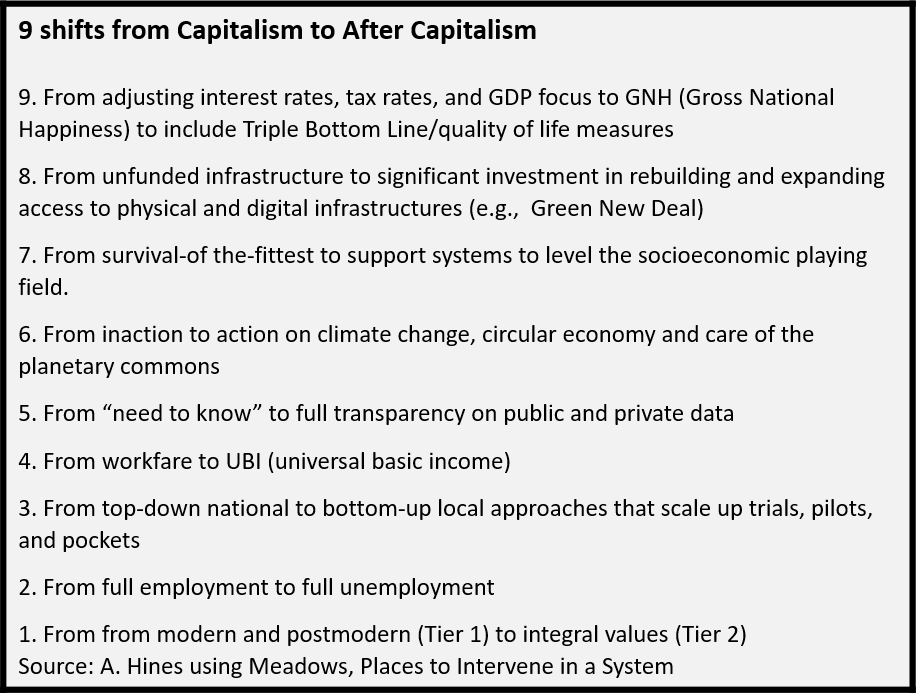 Reflecting on the various arguments I’ve come across for moving beyond capitalism, I thought of one of my favorite change frameworks, Donella Meadow’s masterful “Places to Intervene in a System.” I thought it might be fun to see what is offers to us as we try to imagine “After Capitalism. This is a quick-and-dirty version, so I expect some adjustments will be needed!
Reflecting on the various arguments I’ve come across for moving beyond capitalism, I thought of one of my favorite change frameworks, Donella Meadow’s masterful “Places to Intervene in a System.” I thought it might be fun to see what is offers to us as we try to imagine “After Capitalism. This is a quick-and-dirty version, so I expect some adjustments will be needed!
I briefly characterize each of the intervention points with a quote from Meadow’s piece. They are listed from lowest to highest, that is, leverage point #9 is the weakest, and #1 is the strongest.
| Meadow’s Systems Interventions | Intervention Point in Capitalism |
| 9. Numbers (subsidies, taxes, standards).
“Numbers are last on my list of leverage points. Diddling with details, arranging the deck chairs on the Titanic. Probably ninety-five percent of our attention goes to numbers, but there’s not a lot of power in them.” |
From adjusting interest rates, tax rates, and GDP focus to GNH (Gross National Happiness) to include Triple Bottom Line/quality of life measures |
| 8. Material stocks and flows.
“There’s leverage, sometimes magical, in changing the size of buffers. But buffers are usually physical entities, not easy to change.” |
From unfunded infrastructure to significant investment in rebuilding and expanding access to physical and digital infrastructures (e.g., Green New Deal) |
| 7. Regulating negative feedback loops.
“Nature evolves negative feedback loops and humans invent them to keep system states within safe bounds.” E.g., a thermostat loop |
From survival-of the-fittest to support systems to level the socioeconomic playing field. |
| 6. Driving positive feedback loops.
“Positive feedback loops drive growth, explosion, erosion, and collapse in systems. A system with an unchecked positive loop ultimately will destroy itself.” |
From inaction to action on climate change, circular economy and care of the planetary commons |
| 5. Information flows.
“Delivering feedback to a place where it wasn’t going before.” |
From “need to know” to full transparency on public and private data |
| 4. The rules of the system (incentives, punishment, constraints).
If you want to understand the deepest malfunctions of systems, pay attention to the rules, and to who has power over them. |
From workfare to UBI (universal basic income) |
| 3. The power of self-organization.
The ability to self-organize is the strongest form of system resilience, the ability to survive change by changing. |
From top-down national to bottom-up local approaches that scale up trials, pilots, and pockets |
| 2. The goals of the system.
“…changing the players in a system is a low-level intervention, as long as the players fit into the same old system. The exception to that rule is…if a single player can change the system’s goal. |
From full employment to full unemployment |
| 1. The mindset or paradigm out of which the goals, rules, feedback structure arise
You could say paradigms are harder to change than anything else about a system… But there’s nothing physical or expensive or even slow about paradigm change. In a single individual it can happen in a millisecond. |
From from modern and postmodern (Tier 1) to integral values (Tier 2) [I explain the Tiers as part of this post; a more in-depth treatment here] |
| Source: A Hines, based on D. Meadows, “Places to Intervene in a System,” Whole Earth, Winter 1997. | |
Hopefully, it gives you an idea of some of the shifts that need to take place. I hope you can also see how the shifts at the bottom are much more challenging but also have a much larger impact. And one might argue that the changes at the top, such as the move away from measuring GDP as success, ultimately is connected to the mindset or paradigm at the bottom. In a Homo Economicus that prioritizes economics above all else mindset, GDP makes sense as a measure. Until that mindset changes, it will be challenging to shift that measure.
Putting the shift to integral values and Tier 2 thinking as foundational may be a bit radical, but it is really hard to see fundamental change in Tier 1 mindsets that believe their values are the right values for everybody. We see the tribalism in play today and the stalemate in engenders. In Tier 2, we move off of that “one right way” thinking and have a chance at making the big changes needed. The hard news is that values shifts take a long time! It may seem crazy to counsel patience in the chaos of today, but that may be wise. I’m not suggesting that we sit and wait for values shifts, but recognize that efforts to shift the system today are likely to be very, very difficult, so recognize that and don’t despair – Andy Hines.
Leave a Reply